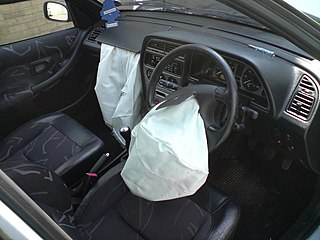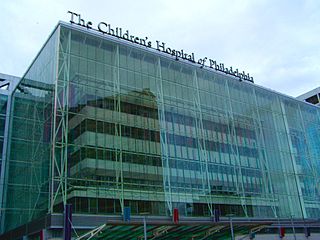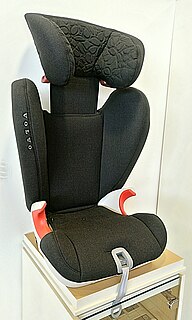Related Research Articles

A seat belt is a vehicle safety device designed to secure the driver or a passenger of a vehicle against harmful movement that may result during a collision or a sudden stop. A seat belt reduces the likelihood of death or serious injury in a traffic collision by reducing the force of secondary impacts with interior strike hazards,by keeping occupants positioned correctly for maximum effectiveness of the airbag,and by preventing occupants being ejected from the vehicle in a crash or if the vehicle rolls over.

An airbag is a vehicle occupant-restraint system using a bag designed to inflate extremely quickly,then quickly deflate during a collision. It consists of the airbag cushion,a flexible fabric bag,an inflation module,and an impact sensor. The purpose of the airbag is to provide a vehicle occupant with soft cushioning and restraint during a collision. It can reduce injuries between the flailing occupant and the interior of the vehicle.

Automotive safety is the study and practice of design,construction,equipment and regulation to minimize the occurrence and consequences of traffic collisions involving motor vehicles. Road traffic safety more broadly includes roadway design.

Shaken baby syndrome (SBS),also known as abusive head trauma (AHT),is the leading cause of fatal head injuries in children younger than two years. Diagnosing the syndrome has continuously proved both challenging and contentious for medical professionals,in that they often require objective witnesses to the initial trauma or rely on uncorroborated recounting. This is said to be particularly problematic when the trauma is deemed 'non accidental'. Some medical professionals propose that SBS is the result of respiratory abnormalities leading to hypoxia and swelling of the brain However,the courtroom has become a forum for conflicting theories with which generally accepted medical literature has not been reconciled. Often there are no visible signs of trauma. Complications include seizures,visual impairment,cerebral palsy,cognitive impairment,and death.

The Children's Hospital of Philadelphia (CHOP) is a children's hospital in Philadelphia,Pennsylvania,with its primary campus located in the University City neighborhood of West Philadelphia in the campus of the University of Pennsylvania. The hospital has 594 beds and more than 1 million outpatient and inpatient visits each year. It is one of the largest and oldest children's hospitals in the world,and United States' first hospital dedicated to the healthcare of children. CHOP has been ranked as the best children's hospital in the United States by U.S. News &World Report and Parents Magazine in recent years. As of 2020,it was ranked number one in the nation by U.S. News for three out of ten specialties. The hospital treats infants,children,teens,and young adults aged 0–21. The hospital also treats adults that would benefit from advanced pediatric care. The hospital is located next to the University of Pennsylvania and its physicians serve as the pediatrics department of the Perelman School of Medicine at the University of Pennsylvania.

A child safety seat,sometimes called a infant safety seat,child restraint system,child seat,baby seat,car seat,or a booster seat,is a seat designed specifically to protect children from injury or death during vehicle collisions. Most commonly these seats are purchased and installed by car owners,but car manufacturers may integrate them directly into their vehicle's design and generally are required to provide anchors and ensure seat belt compatibility. Many jurisdictions require children defined by age,weight,and/or height to use a government-approved child safety seat when riding in a vehicle. Child safety seats provide passive restraints and must be properly used to be effective. However,research indicates that many child safety restraints are often not installed or used properly. To tackle this negative trend,health officials and child safety experts produce child safety videos to teach proper car seat installation to parents and caregivers.
Injury prevention is an effort to prevent or reduce the severity of bodily injuries caused by external mechanisms,such as accidents,before they occur. Injury prevention is a component of safety and public health,and its goal is to improve the health of the population by preventing injuries and hence improving quality of life. Among laypersons,the term "accidental injury" is often used. However,"accidental" implies the causes of injuries are random in nature. Researchers prefer the term "unintentional injury" to refer to injuries that are nonvolitional but often preventable. Data from the U.S. Centers for Disease Control show that unintentional injuries are a significant public health concern:they are by far the leading cause of death from ages 1 through 44. During these years,unintentional injuries account for more deaths than the next three leading causes of death combined. Unintentional injuries also account for the top ten sources of nonfatal emergency room visits for persons up to age 9 and nine of the top ten sources of nonfatal emergency room visits for persons over the age of 9.
The BeSeatSmart Program is a federal grant-based program supported by the Governor's Highway Safety Program,Vermont,and hosted by The Vermont Department of Health. BeSeatSmart provides child passenger safety seats,hands on help,advice,consultations,presentations,training,materials and support to residents of Vermont. BeSeatSmart provides best practice advice as given and sourced by the American Academy of Pediatrics (AAP) and the National Highway Traffic Safety Administration (NHTSA).

Nadine Burke Harris is a Canadian-American pediatrician who has been the Surgeon General of California since 2019;she is the first person appointed to that position. She is known for linking adverse childhood experiences and toxic stress with harmful effects to health later in life. Hailed as a pioneer in the treatment of toxic stress,she is an advisory council member for the Clinton Foundation's "Too Small to Fail" campaign,and the founder and former chief executive officer of the Center for Youth Wellness. Her work was also featured in Paul Tough's book How Children Succeed.

The National Child Passenger Safety Board, managed by the National Safety Council,maintains the quality and integrity of the National Child Passenger Safety Certification Training Program in the United States. The program is used to train and certify child passenger safety technicians and instructors in order to assist caregivers in safe transportation of children. Three of the most common issues that put children at risk:improperly used or installed safety seats,hot cars,and teen drivers. The Board is not limited to keeping kids safe in cars in the U.S. The work of Dr. Marilyn J. Bull to help shape automobile safety law in Chile was highlighted in March 2017 by AAP News.
Anne E. Kazak is an American clinical psychologist,educator and editor. She has focused on pediatric psychology. Much of her research involves "interventions to enhance adaptive functioning and reduce child and family distress associated with serious pediatric illnesses."
Susan Pardee Baker is a professor emeritus of health policy and management at the Johns Hopkins Bloomberg School of Public Health,was the first director of the Johns Hopkins Center for Injury Research and Policy,and is an injury prevention expert. She is also known for developing Injury Severity Scores.

Nadia Lauren Dowshen is an American pediatrician and adolescent medicine physician. She specializes in the care of youth living with HIV infection and medical care to transgender and gender-diverse youth. Dowshen researches health inequality,access to care,and promoting resilience in LGBT youth. As an associate professor at the Perelman School of Medicine at the University of Pennsylvania,she is also the medical director and co-founder of the Gender and Sexuality Development Clinic.
Janet Alma Deatrick is a Professor Emerita at the University of Pennsylvania's School of Nursing.
Beverly L. Davidson is an American geneticist. She is the director of the Raymond G. Perelman Center for Cellular and Molecular Therapeutics at Children's Hospital of Philadelphia. In this role,she investigates gene therapy for neurodegenerative diseases,specifically Huntington's.
Stephan A. Grupp is an American pediatric oncologist. He is the Chief of the Cell Therapy and Transplant Section in the Division of Oncology and Director of the Cancer Immunotherapy Program at the Children's Hospital of Philadelphia and Professor of Pediatrics at the Perelman School of Medicine at the University of Pennsylvania. In 2019,Grupp was elected a Member of the National Academy of Medicine.
Martha A.Q. Curley is an American nurse. She is the Ruth M. Colket Endowed Chair in Pediatric Nursing at Children's Hospital of Philadelphia.
John Matthew Maris is an American pediatric oncologist. He is the Giulio D’Angio Endowed Professor of Pediatrics at the Children's Hospital of Philadelphia (CHOP) and Full Professor at the Perelman School of Medicine at the University of Pennsylvania.
Jordan Scott Orange is an American pediatric immunologist. Orange is credited with defining a new class of diseases known as natural killer cell deficiencies.
Elaine H. Zackai is a Professor of Pediatrics,Director of Clinical Genetics,and the Director of the Clinical Genetics Center at Children's Hospital of Philadelphia (CHOP).
References
- ↑ "Marriage of Koplin / Winston". Baltimore, Maryland: Baltimore Sun. March 20, 1983. Retrieved May 30, 2021– via newspapers.com.
- 1 2 "FLAURA K. WINSTON, MD, PHD". chop.edu. Retrieved May 30, 2021.
- 1 2 "2003 Judson Daland Prize". amphilsoc.org. American Philosophical Society. 2003. Retrieved May 31, 2021.
- ↑ Collins, Hunty (July 21, 1997). "Buckling down the why". The Philadelphia Inquirer. Retrieved May 31, 2021– via newspapers.com.
- ↑ "Three Across the Disciplines". upenn.edu. 1995. Retrieved May 31, 2021.
- ↑ "Post-traumatic stress disorder may follow traffic crashes, according to doctors at The Children's Hospital of Philadelphia". eurekalert.org. Eurekalert. December 6, 1999. Retrieved May 31, 2021.
- ↑ "Faculty Promotions". upenn.edu. October 5, 2004. Retrieved May 31, 2021.
- ↑ "Honors & Other Things". upenn.edu. May 13, 2008. Retrieved May 31, 2021.
- ↑ "FLAURA KOPLIN WINSTON, M.D., PH.D." aimbe.org. Retrieved May 31, 2021.
- ↑ "Dr. Flaura Winston Elected into the National Academy of Medicine for Work on Driving Safety, Injury Prevention". prnewswire.com. October 16, 2017. Retrieved May 31, 2021.
- ↑ "Ms Emily Logan, Chief Commissioner IHREC and Professor Flaura Winston awarded Honorary Fellowship of the Faculty of Paediatrics". rcpi.ie. Royal College of Physicians of Ireland. October 15, 2019. Retrieved May 31, 2021.
- ↑ "Children's Hospital of Philadelphia's Dr. Flaura Winston Receives Clinical and Translational Science Distinguished Investigator Award for Using Research to Inform Public Safety Measures". chop.edu. April 5, 2021. Retrieved May 31, 2021.
- ↑ "Trying to find out why children die in crashes". The Philadelphia Inquirer. July 21, 1997. Retrieved May 30, 2021– via newspapers.com.
- ↑ Strauss, Robert (September 16, 1997). "A Rational Look at Air Bags and Car Child-Safety Devices" (PDF). almanac.upenn.edu. pp. 8–9. Retrieved May 30, 2021.